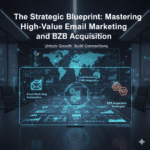For many e-commerce entrepreneurs, email marketing has long been viewed with a mix of necessity and dread. It’s a powerful channel, yet often appears too demanding—too hard to set up, too time-consuming to write content for, and too complex to manage flows and segments effectively.
This perception, however, is being radically changed by Artificial Intelligence (AI). Modern e-commerce platforms are embedding AI into their core functionalities, turning complex, manual processes into simple, conversational tasks. The promise of AI in email marketing is not merely about generating content; it’s about establishing fully automated flows, creating granular customer segments, and leveraging predictive analytics to know when a customer is going to make their next purchase. This integration gets business owners back their valuable time while simultaneously driving significant revenue growth.

Drawing from years of experience in scaling e-commerce stores to seven and eight figures for both personal ventures and major brands, this article will explore five fundamental ways you can leverage AI on your e-commerce platform to not only reclaim your time but also dramatically increase your store’s profitability.
1. AI-Powered Email Flow Automation
An email flow is a series of automated emails sent to a customer based on a specific action or trigger they’ve taken with your store. Traditional flow creation was a tedious process, demanding meticulous, manual setup: creating individual emails, defining triggers, setting wait times, and building complex conditional logic. AI has rendered this process obsolete.
With cutting-edge email marketing platforms, you can now build entire, sophisticated automations simply by describing what you want. Imagine wanting to create an automation for a consumable product, like a popular coffee blend, to ensure customers are reminded to reorder before they run out.
The Conversational Flow Builder
Instead of dragging and dropping countless elements, the AI flow builder acts as an intelligent assistant. You simply input a command, such as:
“When someone makes their first purchase of coffee with us, send an email to them four weeks (28 days) later reminding them to top up. If they don’t purchase within the next 7 days, send a follow-up email with a 5% discount offer.”
The AI processes this natural language request and instantly generates the full flow outline:
- Trigger: Customer orders the “Coffee Product” for the first time.
- Wait Time: Wait 28 days.
- Action 1: Send “Top-Up Reminder Email.”
- Wait Time: Wait 7 days.
- Conditional Split: Check if customer has placed a new order of the coffee product.
- Path A (Yes/No Purchase): If no new purchase, send “5% Discount Offer Email.”
- Path B (Yes/Purchased): Exit the flow.
This eliminates hours of manual configuration and reduces the risk of human error, allowing you to launch high-converting retention flows—like refill reminders, welcome series, or post-purchase follow-ups—in mere minutes.
2. Generating High-Converting Email Content
Once the flow structure is built, the next challenge is filling it with engaging content. Historically, this meant staring at a blank screen, wrestling with copywriting, and struggling to maintain a consistent brand voice. AI now provides a powerful, on-demand copywriting engine integrated directly into the email editor.
Within the email builder, using an AI-generated content feature, you can instruct the system to create a full draft, including copy and layout. For the coffee refill reminder, you might provide a prompt like:
“Create a reminder email with an image placeholder at the top to upload a photo. Below the image, put a short text reminder to buy the coffee. Include a bold heading block that calls out ‘Limited Stock Left.’ Then, insert a section underneath to showcase the coffee product itself.”
In moments, the AI generates several draft options that already integrate placeholder blocks for images and products, a clear call-to-action (CTA) button, and attention-grabbing headline variations like “Limited Stock Alert!” The drafts provide a strong framework, saving the time typically spent on initial layout and core messaging. You can then quickly refine the text, upload a compelling product image, and select the specific products to feature, transforming a basic template into a polished, revenue-ready email.
Note on Platform Choice: Platforms like Klaviyo are purpose-built for e-commerce and embed their AI tools—often referred to as Generative AI or Marketing AI—directly into the workflow. This deep integration is crucial, as it avoids the need for external apps, ensuring the AI has real-time access to the customer and product data needed to generate relevant, on-brand content.
3. Optimizing Email Subject Lines with Brand Voice
A stunning email is worthless if it’s never opened. The subject line is the single most critical factor in achieving a high open rate, and AI is a game-changer for optimizing this crucial element.
The best AI email tools allow you to first define your brand voice. This feature defines your brand’s unique communication style, injecting personality and authenticity so your emails don’t sound like generic, AI-generated boilerplate. You can create custom “voice descriptors” and set specific rules—like the frequency of emojis, punctuation style, or inclusion of direct calls to action—to ensure all content aligns with your brand’s established identity (e.g., “Hyper on Coffee,” using an excited, energetic tone as if someone’s had too much caffeine).

Once the brand voice is established, you can test and generate subject lines using simple keywords or themes. For the coffee refill email, a basic idea might be: “Need some more coffee?”
The AI then regenerates this theme using the established brand voice, providing superior, performance-focused alternatives:
- “Time for a coffee boost? 🚀” (Using an emoji and urgent phrasing)
- “Fuel your day—don’t run dry!” (Energetic and relatable)
- “Grab your coffee—it’s time!” (Short, sharp, and driving curiosity)
By rapidly iterating on a central theme, the AI dramatically increases your chances of creating a subject line that cuts through the noise of a crowded inbox, maximizing your open rates, and driving more clicks and sales.
4. Creating Dynamic Customer Segments with AI
Sending generic emails to a massive list is the antithesis of effective e-commerce marketing. Segmentation is the art of sending the right message to the right person at the right time. AI simplifies the creation of highly targeted segments that were once complex and difficult to define.
Using natural language commands, AI can instantly build segments based on granular purchase behavior. Building on the coffee refill example, you might want to create a segment of customers who have bought once but haven’t repurchased in a specific window, making them ideal targets for your refill flow.

You can input a simple query like:
“Create a segment of customers who have only purchased once and that purchase was over 35 days ago.”
The AI translates this into the platform’s specific segment logic, saving significant time on manual condition setting. The resulting segment, which you might call “Refill Prospects,” will include only customers who meet these precise criteria: placed exactly one order, and the last order date is more than 35 days in the past. This level of precision ensures your automated flow is highly relevant and maximizes its conversion potential.
5. Leveraging Predictive Analytics to Forecast Purchases
This final capability is arguably the most powerful use of AI in e-commerce marketing: predictive analytics. This technology allows the platform to analyze years of historical customer data, behavioral metrics, and purchase patterns to literally predict future behavior.
The AI can use this data to determine:
- Who is most likely to buy next.
- When they are most likely to buy next.
- Their potential Lifetime Value (LTV) and expected spending.
Targeting ‘Likely to Buy’ Customers
You can create an extremely high-value segment simply by asking the AI to predict an immediate buying window. For example:
“Create a segment of customers who are likely to buy from us in the next 30 days.”
The AI identifies customers whose buying frequency and behavior indicate an imminent purchase, generating a segment of “hot” leads—customers who are ready to convert. By sending a highly personalized, targeted campaign to this group, you can ensure you capture that predicted sale, effectively getting in front of them just before they were going to buy.
Hyper-Personalization with Data Insights
Beyond segmentation, AI provides deep insights into the individual customer profile, which allows for a true laser focus in personalization:
- Expected Next Order Date: Pinpoint the perfect day to trigger an email.
- Predicted Spend: Know the customer’s potential value.
- Churn Prediction: Identify customers at risk of leaving to trigger a special win-back campaign.
- Average Time Between Orders: Automate flows based on their personal replenishment cycle, not a generic, one-size-fits-all timeline.
By harnessing these predictive metrics, AI is not just writing emails; it’s providing the data foundation for you to send communications that feel perfectly timed, relevant, and personal. The result is higher engagement, stronger customer loyalty, and unprecedented conversion rates, all operating on autopilot.
Conclusion
The era of complex, manual email marketing is over. AI-driven platforms have democratized sophisticated e-commerce growth strategies, making it easier than ever for businesses of any size to leverage the power of automation and hyper-personalization.
From building entire, conditional email flows with a simple text prompt to generating on-brand email copy and subject lines, and ultimately, using predictive analytics to know exactly who will buy and when, AI has proven itself as an indispensable tool. It eliminates the friction points of traditional email marketing—saving you time, removing the guesswork from segmentation, and ensuring your marketing efforts are maximally effective.
By adopting AI-first solutions, e-commerce businesses can move beyond basic broadcasts and embrace a truly automated, data-driven strategy that delivers higher customer lifetime value and consistent, scalable revenue growth.






